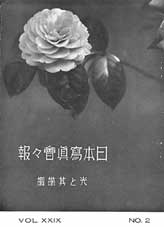PhotoHistory 1920s
Chronology of Japanese photographic history for 1920-1929.
Researched and compiled by Philbert Ono
1921 (Taisho 10)
The Osaka Industrial Material Testing Laboratory (Ministry of Agriculture and Commerce) starts research on optical glass melting. Optical glass had been imported from Germany, France, and England.
Nippon Kogaku Kogyo K.K. hires eight German engineers and scientists on a 5-year contract. They worked on optical design, product design, and lens and prism grinding and polishing. One of them, Heinrich Acht, extended his stay until 1928. He produced samples of photographic lenses, the first ones to come from Nippon Kogaku. SUNAYAMA Kakuno took over lens design after Acht and improved upon Acht's 50cm f/4.8 lens in 1929, calling it "Trimar." In the same year, he later produced the "Anytar" 12cm f/4.0 lens based on the Carl Zeiss Tessar lens.
New photo magazines targeted the new mass market. They include "Camera" (published by Ars) launched in 1921.
Marubell-do opens shop on May 5 in the Shin-Nakamise shopping area in Asakusa, Tokyo to sell and later produce "promide" photos of movie stars and idols. The shop still exists in Asakusa.
1922 (Taisho 11)
Another magazine for the masses, "Geijutsu Shashin Kenkyu," is started (published by Ars), and "Amateur" published by Kinseido.
A number of news photo magazines appear, including "Kokusai Shashin Joho" (published by Kokusai Joho-sha), "Kokusai Jiji Gappo" (later named Sekai Jiji Gappo, published by Kokusai Times-sha), and "Kokusai Gappo" (published by Taishi Tsushin-sha).
1923 (Taisho 12)
The Great Kanto Earthquake strikes on Sept. 1, inevitably destroying valuable photographs and negatives in photo studios and stores in the Tokyo and Yokohama areas. Many photo studio businesses were ruined. Buildings made of steel, concrete, and glass began to emerge during the reconstruction.
Asahi Graph magazine is started by Tokyo Asahi Asahi Shimbun-sha.
The Konishiroku Shashin Senmon Gakko photo school is established in Tokyo, offering a 3-year curriculum. It is renamed Tokyo Shashin Senmon Gakko in 1926 and currently exists as Tokyo Institute of Polytechnics (Tokyo Kogei Daigaku).
1924 (Taisho 13)
Photo Times monthly magazine is established by Photo Times-sha in Oriental Shashin Kogyo's publicity dept. The editor-in-chief is KIMURA Sen'ichi.
 Nihon Shashin-kai (Japan Photographic Society) is established by Fukuhara Shinzo and others. It becomes a major amateur photo group for pictorialism.
Nihon Shashin-kai (Japan Photographic Society) is established by Fukuhara Shinzo and others. It becomes a major amateur photo group for pictorialism.
1925 (Taisho 14)
In June, Konishiroku Honten Co. introduces the Pearlette camera, an imitation of the highly successful Vest Pocket Kodak. It had a bellows and an imported lens and shutter. It used 127-type roll film. The Pearlette line was in production for 20 years and was improved over time.
1926 (Taisho 15 / Showa 1)
Asahi Camera magazine was started by Asahi Shimbunsha newspapers. It was the journal of the All-Japan Association of Photographic Societies (Zen-Nihon Shashin Renmei) which was also established by consolidating various amateur camera clubs.
Hirohito becomes Emperor of Japan.
1927 (Showa 2)
In January, Asahi Camera magazine publishes photos by TAMURA Shigeru which featured still life and nudes. However, Japanese authorities deem the pictorial obscene and orders the magazine to eliminate it. The magazine was then sold with those pages cut out.
In May, the 1st Kokusai Shashin Salon was held by All-Japan Association of Photographic Societies in Tokyo at Asahi Shimbun-sha. About 1,800 works were entered from Japan and 15 other countries.
1928 (Showa 3)
TASHIMA Kazuo establishes the Nichi-Doku Shashin Shokai company, the forerunner of Minolta Camera Co. The corporate name was changed to Molta Goshi Kaisha in 1931 and to Chiyoda Kogaku Seiko K.K. in 1937 when the company began lens production. The first "Rokkor" lens was used on an aerial camera made by the company in 1940. In 1942, the company was ordered by the Imperial Japanese Navy to manufacture optical glass near Kobe. The 75mm f/3.5 Rokkor lens, modeled after the Carl Zeiss Tessar lens, fitted on the Minolta Semi IIIA camera in 1946 was the first Japanese lens with anti-reflection coating.
Through Omiya Shashin Yohin, Asahi Shashin Kogyo markets Japan's first Vest medium-format film called "Kiku Film." Only the emulsion base was imported.
1929 (Showa 4)
The Oriental Shashin Gakko photo school is founded to train photo technicians. A three-month curriculum took in 50 students. The school closes in 1944.
Konishiroku markets Sakura film, the second made-in-Japan film.
Next: PhotoHistory 1930s